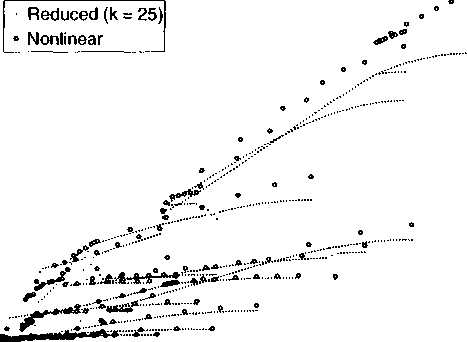1.8
Synaptic Scaling Profile for Neuron AR-1 -20-04-A
0.2

0O 50 100 150 200 250 300 350
Distance from soma (μm)
Figure 2.10: Strengths ‰ of alpha-function synaptic input needed at each compartment of neuron
AR-l-20-04-A to get a 0.2 mV soma depolarization using the BT method. Dots were computed using
the reduced system, while circles were computed using the nonlinear system. The reduced system
size was к = 25.
44
dimension of the linearized system was 6726. The BT matrices were computed in
about 4.6 hours, and setting к = 25 we obtained a reduced system that was 269 times
smaller than the original linearized system and accurate to more than 5 digits.
Using this reduced model, we executed a parameter sweep for ‰ for each compart-
ment, taking a total of 42 minutes. To compare the output to that of the nonlinear
model, we did a sweep for 7 compartments in each branch, taking 268 total minutes.
The results indicate (see Figure 2.10) that the reduced system accurately tracked the
scaling of proximal synaptic inputs while underestimating the scaling for distal con-
ductances. The error in the distal computations is not due to our reduction scheme
but rather to our initial quasi-active hypothesis. Regarding Figure 2.10, a value of
More intriguing information
1. Nach der Einführung von Arbeitslosengeld II: deutlich mehr Verlierer als Gewinner unter den Hilfeempfängern2. AMINO ACIDS SEQUENCE ANALYSIS ON COLLAGEN
3. The name is absent
4. Social Balance Theory
5. Agricultural Policy as a Social Engineering Tool
6. National curriculum assessment: how to make it better
7. The Shepherd Sinfonia
8. Towards Teaching a Robot to Count Objects
9. Strategic Investment and Market Integration
10. Ventas callejeras y espacio público: efectos sobre el comercio de Bogotá